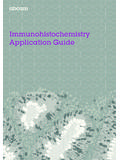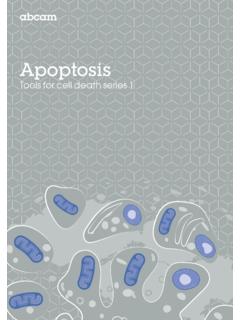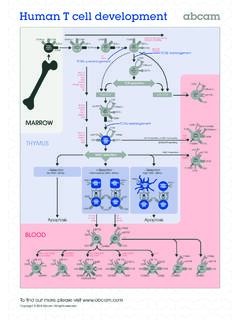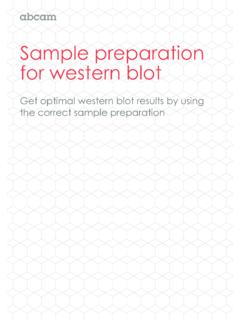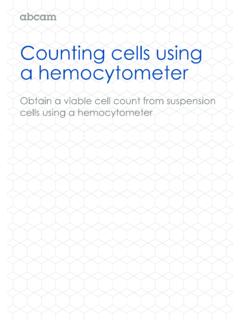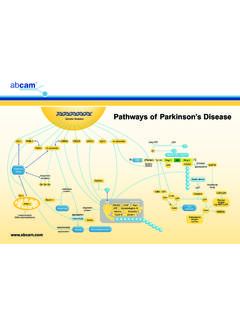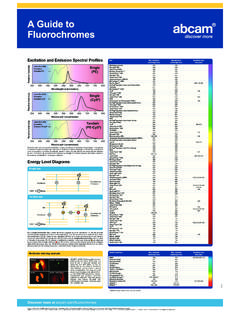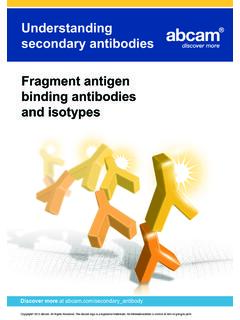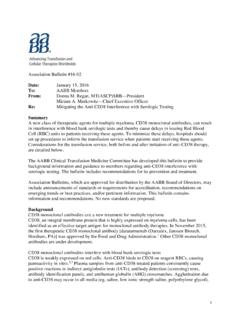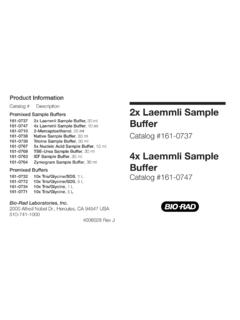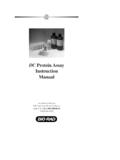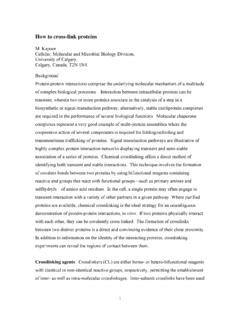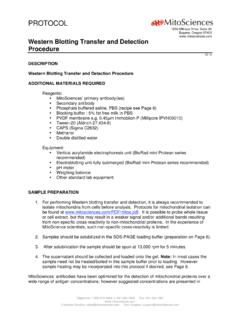Transcription of Immunoprecipitation protocol - Abcam
1 Immunoprecipitation protocol General Immunoprecipitation procedure and required reagents 2 Immunoprecipitation protocol Contents Lysis buffers Other reagents Preparing the lysates Pre-clearing the lysates Immunoprecipitation Washing Elution Choosing the correct beads summary table References Lysis buffers The ideal lysis buffer will minimize protein denaturation while releasing an adequate amount of proteins from the sample. Non-ionic detergents such as NP-40 and Triton X-100 are less harsh than ionic detergents such as SDS and sodium deoxycholate. Other variables that can affect the success of Immunoprecipitation include salt concentration, divalent cation concentration and pH. To optimize the variables, they should be tested within the following ranges (from Harlow and Lane, page 231): Salts: 0 -1 M Detergent, non-ionic: 2% Detergent, ionic: Divalent cations: 0 10 mM EDTA: 0 5 mM pH: 6 9 Non-denaturing lysis buffer Use for antigens that are detergent soluble and are recognized in native form by the antibody.
2 Triton X-100 can be substituted for NP-40. 20 mM Tris HCl pH 8 137 mM NaCl 1% Nonidet P-40 (NP-40) 2 mM EDTA Store up to 6 months at 4 C. Immediately before use add protease inhibitors. For convenience, a 10% sodium deoxycholate stock solution (5 g into 50 mL) may be prepared. It must be protected from light. 3 Detergent-free soluble protein lysis buffer Some soluble proteins may not require use of detergents. Use this buffer with mechanical cell lysis such as homogenization with a Dounce homogenizer. PBS containing: 5 mM EDTA sodium azide Store up to 6 months at 4 C. Immediately before use add protease inhibitors. Denaturing lysis buffer for non-detergent soluble antigens Epitopes of native proteins are not accessible to antibodies that only recognise denatured proteins.
3 When harvesting and lysing the cells, heat the cells in denaturing lysis buffer. This method can also be used for antigens that cannot be extracted from the cell with non-ionic detergents. Use of DNase1 will aid extraction of proteins from chromatin. 1% SDS 5 mM EDTA Store up to 1 week at room temperature. Immediately before use add 10 mM dithiothreitol or beta-mercaptoethanol Protease inhibitors15 U/mL DNase1 Wash buffers 10mM Tris; adjust to pH 1mM EDTA 1mM EGTA; pH 150mM NaCl 1% Triton X-100 sodium orthovanadate Protease inhibitor cocktail Store up to 6 months at 4 C. Immediately before use add protease Immunoprecipitation protocol Other reagents Protease inhibitors Proteolysis, dephosphorylation and denaturation begin as soon as cells are lysed.
4 Putting samples on ice will slow down these processes, but protease and phosphatase inhibitor cocktails are also available. If not using a cocktail, PMSF (50 g/mL) and aprotinin (1 g/mL) are protease inhibitors commonly used for Immunoprecipitation . Other reagents Sterile PBS pH Sterile PBS-BSA 1% w/v (filtered) TBST buffer Loading/sample buffer for western blotting VeriBlot for Immunoprecipitation secondary antibodies, which preferentially detect the non-reduced, non-denatured primary antibody during western blotting. 100 mM EDTA stock solution is made with g EDTA dissolved into 40 mL H2O. Add NaOH to adjust the pH to Finally, adjust the total volume to 50 mL. Preparation of lysates Lysates from cell culture (non-denaturing) 1.
5 Place the cell culture dish on ice and wash the cells with ice-cold PBS. 2. Drain the PBS, then add ice-cold lysis buffer (1 mL per 107 cells/100 mm2 dish/150 cm2 flask; mL per 5x106cells/60 mm2 dish or 75cm2 flask). 3. Scrape adherent cells off the dish using a cold plastic cell scraper then gently transfer the cell suspension into a pre-cooled microcentrifuge tube. 4. Maintain constant agitation for 30 min at 4 C. 5. Centrifuge in a microcentrifuge at 4 C. You may need to vary the centrifugation force and time depending on the cell type. A guideline is 20 min at 12,000 rpm but you should optimize this for your specific experiment (eg leukocytes need a very light centrifugation). 6. Gently remove the tubes from the centrifuge and place on ice.
6 Aspirate the supernatant and place in a fresh tube kept on ice, and discard the pellet. 5 Lysates from cell culture (denaturing) 1. Add 100 L denaturing lysis buffer to 2x107 cells. 2. Mix well by vortexing vigorously for 2 3 sec at maximum speed. Transfer the cell suspension to a microcentrifuge tube. The solution can be viscous at this stage due to release of DNA. 3. Heat samples to 95 C for 5 min to denature. 4. Dilute the suspension with mL non-denaturing lysis buffer. Mix gently. The excess 1% Triton X-100 in the non-denaturing lysis buffer quenches the SDS in the original denaturing buffer. 5. Fragment the DNA by passing the lysed suspension 5 10 times through a needle attached to a 1 mL syringe. Repeat mechanical disruption until the viscosity is reduced to manageable levels.
7 If the DNA is not fully digested and fragmented, it can interfere with the separation of the pellet and supernatant following centrifugation. 6. Incubate on ice for 5 min. 7. Proceed with the Immunoprecipitation Lysates from tissue 1. Dissect the tissue with clean tools and as quickly as possible. If possible, do this on ice to prevent degradation by proteases. 2. Place the tissue in round-bottom microcentrifuge tubes and immerse in liquid nitrogen to snap freeze. Store samples at -80 C for later use or keep on ice for immediate homogenization. 3. For a ~5 mg piece of tissue, add ~300 L lysis buffer rapidly to the tube and homogenize with an electric homogenizer. 4. Rinse the blade twice with another 300 L lysis buffer per rinse and then maintain constant agitation for 2 h at 4 C (eg place on an orbital shaker in the refrigerator).
8 Volumes of lysis buffer must be determined in relation to the amount of tissue present. Protein extract should not be too dilute to avoid loss of protein and to minimize the sample volume to be loaded onto gels. The minimum concentration is mg/mL; optimal concentration is 1 5 mg/mL. If denatured samples are required, use denaturing lysis buffer and perform Steps 2 5 from the denaturing protocol above. 5. Centrifuge for 20 min at 12,000 rpm at 4 C in a microcentrifuge. Gently remove the tubes from the centrifuge and place on ice, aspirate the supernatant and place in a fresh tube kept on ice. Discard the Immunoprecipitation protocol Pre-clearing the lysates Pre-clearing the lysate can help reduce non-specific binding and reduce background.
9 However, if the final detection of the protein is by western blotting, pre-clearing may not be necessary unless a contaminating protein is interfering with visualization of the protein of interest. 1. Add either 50 L of off-target antibody of the same species and isotype as the Immunoprecipitation antibody, or normal serum (rabbit is often preferred, see Harlow and Lane, page 243) to 1 mL of lysate. Incubate for 1 h on ice. 2. Add 100 L of bead slurry to the lysate. 3. Incubate for 10 30 min at 4 C with gentle agitation. 4. Spin in microcentrifuge at 14,000 x g at 4 C for 10 min. 5. Discard bead pellet and keep supernatant for Immunoprecipitation . To increase the yield, the beads can be washed 1 or 2 more times in lysis buffer, and the supernatants collected together.
10 It is important to make sure that as much of the normal serum is removed as possible, as this will compete with the antibody against the antigen of interest. To check for this, a test can be done with lysis buffer instead of sample, performing all pre-clearing steps as above. Running a gel of the resulting supernatant and staining with Coomassie will reveal if the serum Ig is being removed effectively. If serum has not been sufficiently removed, bands will be present at 50 and 25 kDa for heavy and light chains; its presence may contribute to a weak Immunoprecipitation . Consider either decreasing the amount of serum or increasing the amount of beads incubated with your samples in the pre-clearing step. 7 Immunoprecipitation protocol Immunoprecipitation There are a few different methods to immunoprecipitate proteins.
